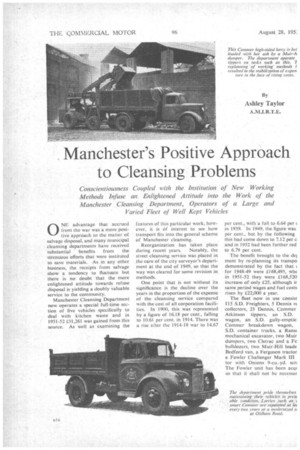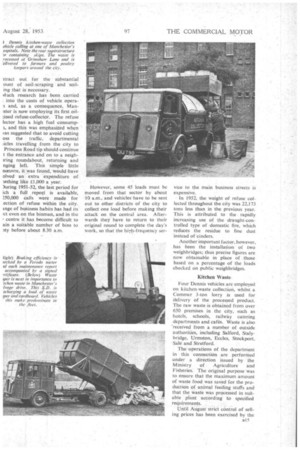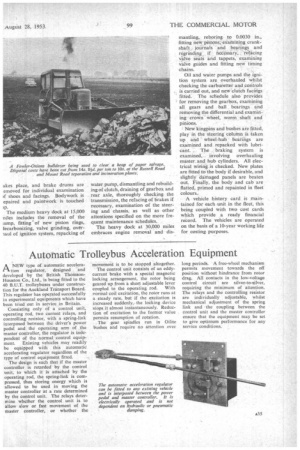Manchester's Positive Approach to Cleansing Problems
Page 48

Page 49

Page 50

Page 53

If you've noticed an error in this article please click here to report it so we can fix it.
Conscientiousness Coupled with the Institution of New Working Methods Infuse an Enlightened Attinule into the Work of the Manchester Cleansing _Department, Operators of a Large and Varied Fleet of Well Kept Vehicles
By
Ashley Taylor
A.M.I.R.T.E.
ONE advantage that accrued from the war was a more positive approach to the matter of salvage disposal, and many municipal cleansing departments have received substantial benefits from the strenuous efforts that were instituted to save materials. As in any other business, the receipts from salvage show a tendency to fluctuate but there is no doubt that the more enlightened attitude towards refuse disposal is yielding a doubly valuable service to the community.
Manchester Cleansing Department now operates a special full-time section of five vehicles specifically to deal with kitchen waste and in 1951-52 1:31,261 was gained from this source. As well as examining the features of this particular work, how'ever, it is of interest to see how transport fits into the general scheme of Manchester cleansing.
Reorganization has taken place during recent years. Notably, the street cleansing service was placed in the care of the city surveyor's department at the end of 1949, so that the way was cleared for some revision in methods.
One point that is not without its significance is the decline over the years in the proportion of the expense of the cleansing service compared with the cost of all corporation facilities. In 1900, this was represented by a figure of 16.18 per cent., falling to 10.61 per cent. in 1914. There was a rise after the 1914-18 war to 14.67 per cent., with a fall to 6.64 per c in 1939. in 1949, the figure was per cent., but by the following this had come down to 7.12 per c and in 1952 had been further red to 6.79 per cent.
The benefit brought to the dej ment by re-planning its transpo demonstrated by the fact that c for 1948-49 were I:168,495, wit( in 1951-52 they were £168,520 increase of only £25, although ir same period wages and fuel costs risen by £22,000 a year.
The fleet 'now in use consist 115 S.D. Freighters, 5 Dennis a collectors, 23 Dennis, Commer Atkinson tippers, an S.D. wagon, an S.D. gully-emptie. Commer breakdown wagon, S.D. container trucks, a Ranst mechanical excavator, two Muir dumpers, two Cletrac and a Fe bulldozers, two Muir-Hill bade Bedford van, a Ferguson tractor a Fowler Challenger Mark III tor with Onions 9-cu.-yd. scn The Fowler unit has been acqt so that it shall not be necessar itract out for the • substantial ount of soil-scraping and soil ing that is necessary.
vluch research has been carried . into the costs of vehicle opera1 and, as a consequence, Manster is now employing its first oil;hied refuse-collector. The refuse lector has a high fuel consump1, and this was emphasized when vas suggested that to avoid cutting oss the traffic, departmental tides travelling from the city to Princess Road tip should continue t the entrance and on to a neighwing roundabout, returning and nging left This simple little nceuvre, it was found, would have olved an extra expenditure of tething like £1,000 a year.
)uring 1951-52, the last period for ich a full repoct is available, 250,000 calls were made for ection of refuse within the city. tnge of business habits has had its !ct even on the binman, and in the centre it has become difficult to am n a suitable number of bins to 3ty before about 8.30 a.m. However, some 45 loads must be moved from that sector by about 10 a.m., and vehicles have to be sent out to other districts of the city to collect one load before making their attack on the central area. Afterwards they have to return to their original round to complete the day's work, so that the hi7h-frequency ser vice to the main business streets is expensive.
• In 1952, the weight of refuse collected throughout the city was 22,173 tons less than in the previous year. This is attributed to the rapidly increasing use of the draught-controlled type of domestic fire, which reduces the residue to fine dust instead of cinders.
Another important factor, however, has been the installation of two weighbridges; thus precise figures are now obtainable in place of those based on a percentage of the loads checked on public weighbridges.
Kitchen Waste.
Four Dennis vehicles are employed on kitchen-waste collection, whilst a Commer 3-ton lorry is used for delivery of the processed product. The raw waste-is obtained from over 650 premises in the city, such as hotels, schools, railway catering departments and cafes. Waste is also 'received from a number of outside authorities, including Salford, Stalybridge, Urmston, Eccles, Stockport, -Sale and Stretford.
The operations of the department in this connection are performed under a direction issued by the Ministry of Agriculture and Fisheries. The original purpose was to ensure that the maximum amount of waste food was saved for the production of animal feeding stuffs and that the waste was processed in suitable plant according to specified requirements. .
Until August strict control of selling prices has been exercised by the
• Ministry,. so_ that there .has : been little chance of substantial profits, but it is now expected that the product will find its own price level. AS there is a lengthy waiting list for supplies,' the position 'should become more advantageous to-the producers.
In 1951-52, the cleansing department's Grimshaw Lane depot dealt with 6,354 tons of this waste food, which was converted into 4,216 tons of pig and poultry feeding stuffs. The kitchen waste received is paid for on a sliding scale according to quality.
The four machines employed on kitchen-waste duties are smartly turned out and have bodies that were adapted in the department's own workshops, there being a special carrier for the clean bins, and rear doors which are completely watertight. In all cases, the machines work to a strictschedule, it being necessary that catering establishments shall know with some certainty when collections are likely to be made.
Each vehicle has a specific round and route, collecting daily, or two, three or four times weekly. Between them, the four machines deal with the entire municipal area, including all the schools.. They average two loads per day and consistent quantities of waste are collected.
Protein Content
The waste is sent to Grimshaw Lane for processing and, because' it is fortified with waste offal; waste fish and similar constituents to give protein to the extent of 1 per cent. above the normal rate of 5-6 per cent., the product has qualified for a price supplement of 10s. per ton. After processing, the supplies are delivered by the Commer lorry to farmers and poultry keepers within a 15-20-mite. radius. The animal feeding stuffs thus produced earned £36,495 during the year to March 31 last.
'Other revenue earners include scrap metal, waste textiles, tallovv and waste paper, the last-mentioned being second in importance to the animal foods. During 1951-52, the 'separation and incineration plants at Russell Road and Mount Road reduced disposal costs to 10s. per ton, compared with 14s. 8-id. for the previous year. This favourable result was achieved through an increase in salvage, chiefly in the wastepaper section.
The last of the Manchester Cleansing Department horses went into retirement just over two years ago. .Since that time, much has been done by the director of public cleansing,
Bi 6 Mr.. Alan E. Bart on,:.to .:•stimulate interest within the organization in. improved maintenance and cleanli:ness of the vehicle fleet.
In 1951, the annual vehicle parade was revived as a culmination to inspections held at the various depots with the object of selecting the bestmaintained machines. Three inspections take place at each depot during the year and the drivers, who. are responsible for general cleaning, greasing and oil changing, participate in a prize, scheme based on the marks that have been awarded by the inspecting, panel.
In order even to be eligible for a maximum number of points, a high standard must be reached.. The chassis frame and wheels must have been thoroughly cleaned, including inside the chassis. Body cleanliness must extend to such points as the underside at the rear and the panels between the body and the driver's cab, whilst floor and engine panels must be ,free from oil, grease or grit.
Tyres have to be inflated to correct pressure and be free from flints, broken glass and so on. Oil levels have, of course, to be correct and battery terminals clean and free from verdigris, whilst battery crates must be free from corrosion. Surplus grease and dirt must be removed from around the shackles and grease nipples.
All this has brought about a progressive improvement, and there is no doubt that it has raised the morale of the driving and collection staff.
Special care is now taken in the recruitment of the department's drivers. They are chosen from among the refuse collection general staff and are sent to Water Lane, where there is a full-time driving and maintenance instructor with every facility for tuition, to say nothing of a vehicular " chamber . of horrors which effectively demonstrates the manner. in• which misuse may. cau the collapse of vital components.
Manchester's motto might "cleansing vehicles must be clet vehicles,", for although the wo naturally has an adverse effect on t finish, the most strenuous efforts a made to maintain a presentat appearance. A paint shop that w formerly established at the Wat Lane depot has now been transferr to a modernized building at Oldha Road and here the bodies a repainted at intervals of 18months, repainting being entirely brush.
The department carries out neat all its own repairs, maintenance bei on a mileage basis. Ten mechan at the Water Lane garage perfot
the work, the operations carried within the depot including everyth but crankshaft grinding and simi special jobs. The schedule usut, followed provides for "A" servic every 2,000 miles.
At this stage the engine oil changed, fuel and oil filters checked, tappet clearances examin air filters cleaned and the eng tuned. Gearbox and axle oil lei are inspected, universal coupli and propeller-shaft races are Jul cated, the steering box is topped and the steering generally inspect Chassis and springs are inspect the lighting system examined detail, whilst equipment such as ping gear is tested. Tools checked and body bolts tighter The inside of the body is painted v bituminous paint.
Brakes, both hand and foot, tested with the aid of a Fen meter. Each maintenance repor accompanied by a signed Fen certificate on which are enteredpercentages of braking efficiency.
Each 7,500 miles, there is a I dock, with numerous additic items. At this stage decarbonizat
akes place, and brake drums are emoved for individual examination if shoes and facings. Bodywork is epaired and paintwork is touched ip.
The medium heavy dock at 15,000 Mies includes the removal of the .ump, fitting of new piston rings, iecarbonizing, valve grinding, overlaul of ignition system, repacking of water pump, dismantling and rebuilding of clutch, draining of gearbox and rear axle, thoroughly checking the transmission, the refacing of brakes if necessary, examination of the steering and chassis, as well as other attentions specified on the more frequent maintenance schedules.
The heavy dock at 30,000 miles embraces engine removal and dis-,
mantling, reboring to 0.0030 in., fitting new pistons, examining crankshaft journals and bearings and regrinding if neCessary, refacing valve seats and tappets, examining valve guides and fitting new timing chains.
Oil and water pumps and the igni tion system are overhauled whilst checking the carburetter and controls , is carried out, and new clutch facings fitted. The schedule also provides for removing the gearbox, examining all gears and ball bearings and removing the differential and examining crown wheel, worm shaft and pinions.
New kingpins and bushes are fitted, play in the steering" column is taken up and wheel-hub bearings are examined and repacked with lubricant. . The braking system is examined, , .involving overhauling master. and hub cylinders. All electrical wiring .is checked. New plates are fitted to the body if desirable, and slightly damaged panels are beaten out. Finally, the body and cab are flatted, primed and repainted in fleet colours., A vehicle history card is maintained for each unit in the fleet, this being coupled with two cost cards which provide a ready financial record. The vehicles are operated on the basis of a 10-year working life for costing purposes.




















































































